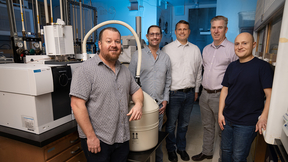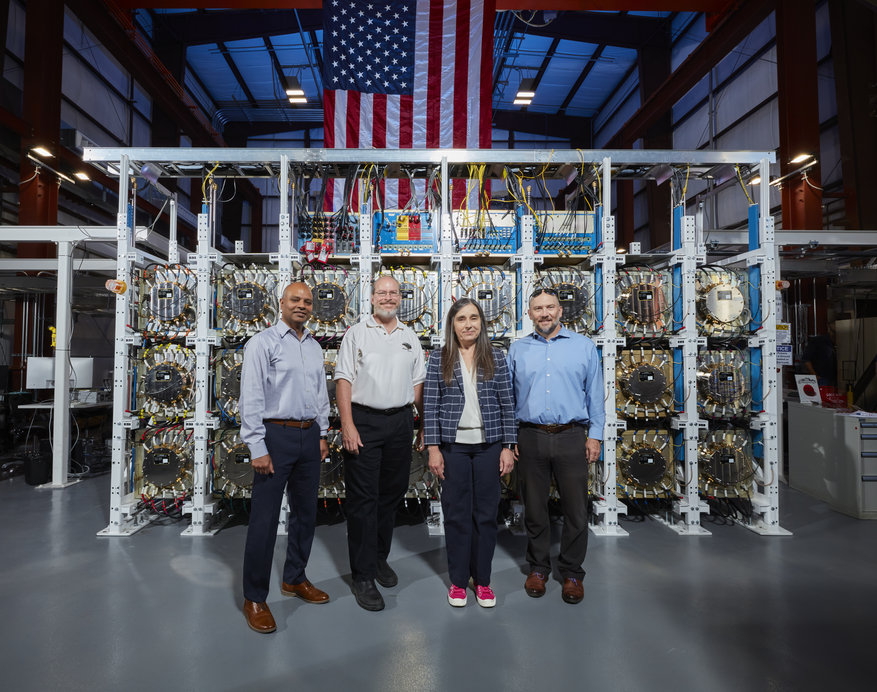Scorpius Accelerator: 24 line-replaceable units mark major milestone
 (Download Image)
(Download Image)
Lawrence Livermore National Laboratory this week marked the completion of 24 line replacement units (LRUs) for the Scorpius accelerator. This marks a major milestone in the development of the next-generation electron beam accelerator for X-ray imaging during subcritical experiments. (Photo: Garry McLeod/LLNL)
Members of Lawrence Livermore National Laboratory’s (LLNL’s) Advanced Sources and Detectors (ASD) Scorpius accelerator team recently marked a major milestone in the project — the delivery of 24 line-replaceable units (LRUs), known as pulsers, forming a complete unit cluster. The LRUs will power the Scorpius electron beam accelerator, which will capture multiple X-ray images of dynamic explosive experiments important to ensuring that the nation's nuclear deterrent remains safe and effective without full-scale nuclear testing.
“This accelerator will enable us to capture multiple late-time radiographic images of subcritical experiments,” said Brad Wallin, deputy director for Strategic Deterrence, at a ceremony marking the occasion. “The accomplishment we celebrate today establishes strong confidence in this technology and our readiness to deliver through production.”
Eventually housed at the Nevada National Security Site in Nevada, the Scorpius accelerator will be a 125-meter-long linear induction accelerator that creates short, high-energy bursts of X-rays to take radiographic images of contained subcritical experiments performed with special nuclear material, specifically plutonium. The X-rays will serve as a diagnostic tool, allowing researchers to assess the effects of aging and manufacturing methods on a nuclear weapon.
Using Scorpius, scientists will learn how this special nuclear material acts when driven by high explosives, which will in turn enable an accurate assessment of the enduring stockpile and certification of modernized nuclear warheads. Scorpius will serve as a vital diagnostic installed 963 feet below ground, providing direct experimental evidence of device configuration, and supporting the validation of Los Alamos National Laboratory (LANL) and LLNL computer codes.
LRUs are a critical component of Scorpius, providing the flexibility, reliability and stability necessary for scientists to tune accelerator pulses for specific experiments in ways previously unavailable. To power the machine, millions of commercial semiconductors, resistors and capacitors are discharged to form a very narrow pulse using integrated circuitry and complex control systems. Inside every LRU are 45 printed circuit boards, each with 80 channels comprised of a variety of electrical components.
“The beauty of solid-state pulsers is that researchers can turn them on and off whenever necessary, adjust the duration that a pulse remains on, and modify the duration between pulses and bursts, offering tremendous flexibility,” said Vincent Riot, ASD Scorpius senior team lead for LLNL. “Furthermore, only two people are needed to replace a pulser when one stops working, and they can be replaced in approximately 20 minutes, allowing the machine to continue functioning.”
With this milestone met, 220 LRUs will be assembled and shipped to power the accelerator’s injector so the team can begin integrated testing. After that, the team will add the remaining 780 LRUs needed to make Scorpius fully operational. In total, the Scorpius accelerator will be outfitted with 984 LRUs, with the additional 16 LRUs serving as spares.
The project is a joint effort between LANL as the project office and lead for the accelerator cells and downstream transport; LLNL as lead for pulsed-power; Sandia National Laboratories as lead for the injector; and Nevada National Security Site as the lead for commission and long-term operation.
–Karen Leonard
Contact
 Paul Rhien
Paul Rhien
[email protected]
(925) 422-4206
Tags
Threat preparednessStrategic Deterrence
Nonproliferation
Featured Articles








